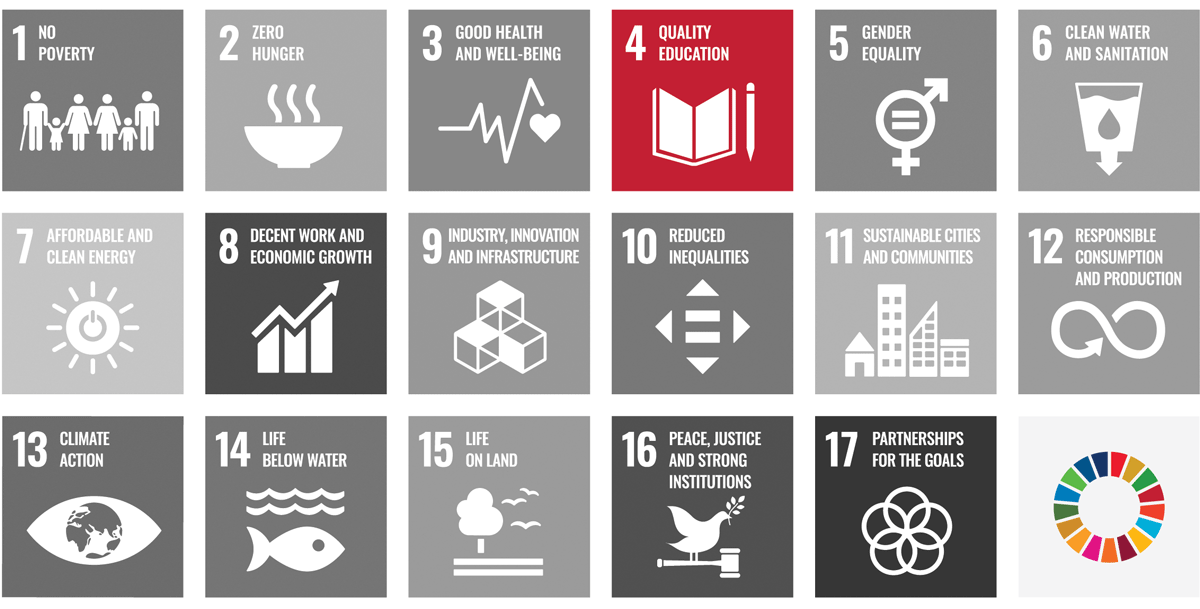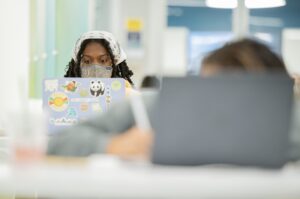
What does a more sustainable future look like in Pittsburgh? Our team will take a deeper look at each of the 17 UN Sustainable Development Goals (SDGs) developed in 2015 by the United Nations General Assembly as part of the 2030 agenda for Sustainable Development. Each of the 17 goals are interconnected and act as a blueprint for creating a better world for all.
The fourth UN Sustainable Development Goal is to “ensure inclusive and equitable quality education and promote lifelong learning opportunities for all.” Some of the targets focus on providing equitable, effective, and affordable education for all children, youth, and adults, achieving higher levels of literacy and numeracy, building and upgrading safe and inclusive facilities, and increasing supply of quality teachers and teacher training.
Education is truly the foundation for everything we do and provides a basis for our social, emotional, and cognitive abilities — which have been affected greatly in the past few years.
Education is the most powerful weapon which you can use to change the world.
It is no surprise that the state of education has been significantly changed by the COVID-19 pandemic. An additional 101 million children (9 percent) in grades 1 through 8 fell below minimum reading proficiency levels in 2020. Schools were forced to shut down and shift to a remote learning model, while students struggled with independent learning, time management, screen fatigue, and lack of social interaction. Many lower-income schools and populations felt the effects even harder, without access to many of the schools’ resources.
But the situation around the world was dire even before the pandemic hit: 617 million youth worldwide lack basic mathematics and literacy skills and some 750 million adults — two thirds of them women — remained illiterate in 2016.
The City of Pittsburgh is taking this goal seriously:
- Under former Mayor Bill Peduto, the city introduced a $2 million fund to boost the quality of early learning and Pre-K by improving childcare facilities.
- The City’s Department of Parks and Recreation and Sprout Fund created Rec2Tech, a learning STEM/technology challenge for grades 7 through 12.
- In 2015, the City appointed a local coordinator for President Obama’s program My Brother’s Keeper, focusing on educational policy and programs for Black men and boys.
- Organizations like the Readiness Institute at Penn State aim to prepare each and every Pittsburgher for personal, professional, and civic success
The Future of Pittsburgh Education

We recently chatted with Emma Hance, program manager at the Readiness Institute at Penn State, about the importance of quality and inclusive education and the future of Pittsburgh education.
What does quality education mean to you? What are the key components necessary for a child to receive quality education?
Quality education is student-centered and is shaped and driven by the needs of the learners, families, and communities that schools serve. A quality education is one that allows all learners to reach their highest potential and unlock pathways to future success.
Some of the key components of quality education (inspired by an article from Norad) include:
- experienced, caring teachers
- dynamic, differentiated instruction
- rich, culturally relevant curricula
- safe, secure, inclusive, and inspiring learning environment for students (and work environment for teachers and staff)
- effective school management: administration (both building and district) is transparent with staff, families, and students about expectations and decision-making process
- wraparound support services for students and families
- adequate and equitable funding
A question that is often discussed in schools is “how do we prepare students for an unknowable future?” This question has become more pressing over the past 20 years with the increased interconnectivity of the internet and has only become more salient with the emergence of Industry 4.0 and the drastic changes that we’ve seen as a result of the COVID-19 pandemic. Therefore, it has become increasingly important to embed future readiness skills like innovative thinking, resilience, and learner empowerment into all aspects of education, for while we can’t prepare our learners for a future that we cannot yet envision, we can equip them with the skills that they will need to embrace and tackle these future challenges.
What are some of the biggest roadblocks in providing quality education — especially for some of the Pittsburgh community?
Globally:
- According to a joint report published by UNICEF and UNESCO, “poverty is the most pervasive barrier to education and often exacerbates the other factors that keep children from attending school and learning.”
- Other key barriers named include child labor, conflict (i.e., political upheaval and war or violence linked to organized crime, drugs, and gang warfare), disability, gender discrimination, and language barriers.
Locally:
- There is inequitable school funding across the state and county; there are 41 public school districts in Allegheny County (not counting local charter schools) and many are receiving unbalanced funds for the populations they serve.
- In 2008, Pennsylvania passed Act 61, which provided schools with extra funding, factoring in things like the number of children in the district living in poverty, the number of English language learners, district size, and the differences in cost of living across the state. Then in 2011, Governor Corbett cut $1 billion from state education funding and dismantled the funding formula. Thanks to pressure from state educators, a new Basic Education Funding Commission was created in 2014 to explore the creation and implementation of a new funding formula, which was passed into law in 2016. While PA’s new funding formula has begun to address issues in school funding, we still have a long way to go when it comes to undoing the impact of historic, ingrained inequity.
Why is it so important for education to be inclusive and equitable?
Students need to be able to show up and engage as their full, authentic selves. In order to truly learn, we have to feel valued and be comfortable making mistakes, which requires a degree of vulnerability. If students are concerned about negative reactions from their peers and/or other factors outside of the classroom, they are more likely to have their guards up and will not be able to show up fully ready — or able — to learn.
What are some steps schools and the education system can take to become more inclusive and equitable?
In 2018, the Human Rights Campaign put out a list of “Tips for Making Classrooms More Inclusive as Students Head Back to School.” While the list specifically references steps that educators can take to make their classrooms more gender-inclusive and a more welcoming place for LGBTQ students, many of the suggested tips can also be applied to create a more welcoming environment for students with a variety of identities and from diverse backgrounds.
It is also worth noting that our society often regards schools as THE place to fix the education system; however, many of the current issues that we are seeing within our education system are the result of other social issues. When learners are no longer struggling with housing and food insecurity, lack of access to healthcare, family trauma, and a host of other ills, only then will they be able to show up in our classrooms ready to learn and chart their futures.
The Readiness Institute at Penn State, funded by The Heinz Endowments, is a Penn State Outreach initiative that creates personalized pathways to success for every learner.
Check out the rest of our blog posts on UN Sustainable Development Goals

